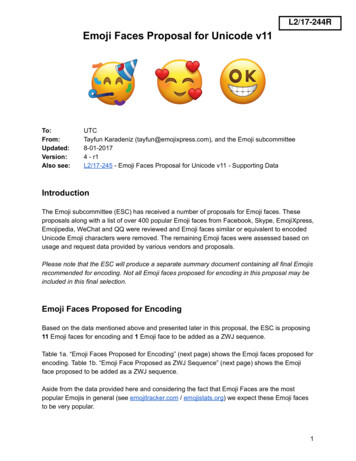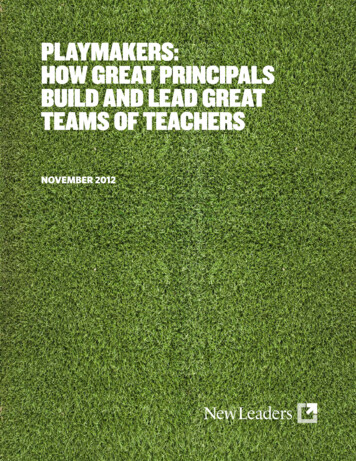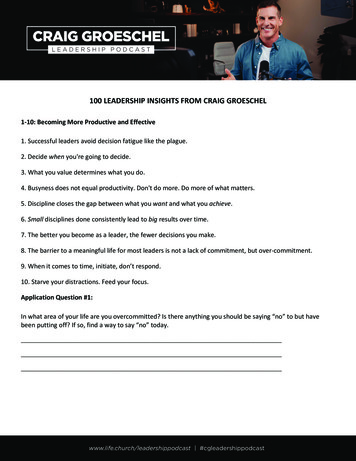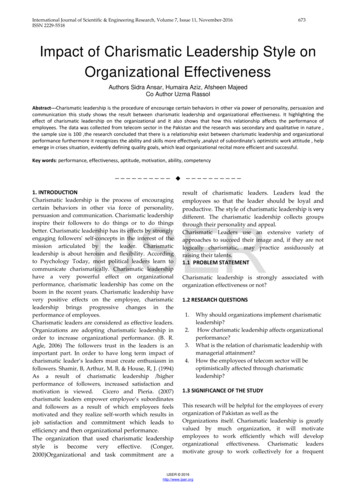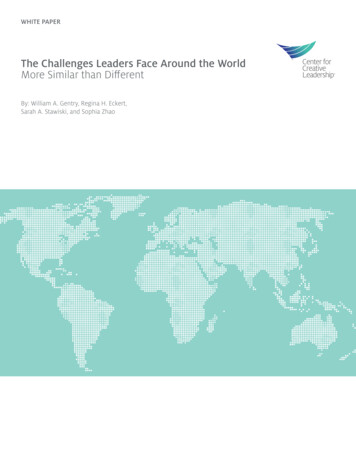
Transcription
WHITE PAPERThe Challenges Leaders Face Around the WorldMore Similar than DifferentBy: William A. Gentry, Regina H. Eckert,Sarah A. Stawiski, and Sophia Zhao
ContentsOverview2Why Look at These Challenges?3Main Finding: Six Common Challenges across Seven Countries4What Can Be Done to Help Leaders Overcome These Challenges?5Develop Managerial Effectiveness5Develop Relationship Skills8Develop Skills to Enact Change10Develop Skills to Cope with Organizational Politics11Conclusion14About the Research15Endnotes16About the Authors17
OverviewWhat are the challenges of those who are leading from the middleand executive levels of organizations? Many people speculateabout them. Our research at the Center for Creative Leadership(CCL ) identified these challenges from a proven and reliablesource—from the words of those leading from the middle andexecutive levels of organizations facing these challenges everysingle day. We gathered data from 763 participants of leadershipdevelopment programs from seven different places in the world(China/Hong Kong, Egypt, India, Singapore, Spain, UnitedKingdom, and United States). Though they come from all parts ofthe world, these leaders consistently face the same six challenges: Developing Managerial EffectivenessInspiring OthersDeveloping EmployeesLeading a TeamGuiding ChangeManaging Internal Stakeholders and PoliticsWe explain what these six challenges are, and how leaders cancope with them. We also implore those who design and implementtraining and development initiatives to understand thesechallenges. If you understand the challenges leaders face, you willbe better able to design initiatives aimed at their development.2 2016 Center for Creative Leadership. All rights reserved.
Why look at these challenges?The life of a modern-day leader clearly is noteasy. Inside their organizations, they need tolead and motivate a diversified group of people,work across organizational boundaries, improveefficiency, and achieve growth. Externally, theyface a complex and globalized environment;they have to manage the requirements ofgovernment, keep up with competitors, andmeet the expectations of other stakeholders.And within this global environment, there aremany cultural considerations leaders must faceto be effective. They must work across culturalboundaries and alongside others who, at times,are very different from them and have differentways of getting work completed.These are difficult challenges, and many leadersfeel ill-prepared to tackle them. Developingleaders who can face these challenges is trickyindeed. Of course, some training needs andcontent can be derived from organizationalstrategy and planned change initiatives. Yetmany leaders have other needs and challengesthat strategy or change initiatives do notcover. So what are those challenges, and howcan a company ensure that training actually isdesigned to meet the development needs of aspecific leader?To help companies clarify these issues, weinvestigated the main challenges leaders facearound the globe and whether the challengesdiffer depending upon geographic location.The findings will not only help practicingleaders understand what they and othersaround the world are going through, but alsoinform training and development initiatives toensure that developmental opportunities areappropriately targeted. Our research examineddata from 763 participants of leadershipdevelopment programs from seven differentplaces in the world: China/Hong Kong, Egypt,India, Singapore, Spain, United Kingdom, andUnited States. Through their own words, themost significant challenges these leadersface are relatively similar across all sevenlocations. In this white paper, we review eachof these challenges and ways leaders caneffectively deal with them. 2016 Center for Creative Leadership. All rights reserved.3
Main FindingSix Common Challenges across Seven CountriesLooking across the countries, there are six main categories that comprise morethan half of all challenges. In addition, these six are ranked among the Top 10challenges leaders face in each country. In order of frequency, they are: Developing Managerial Effectiveness—The challenge of developing therelevant skills—such as time management, prioritization, strategic thinking,decision-making, and getting up to speed with the job—to be more effectiveat work. Inspiring Others—The challenge of inspiring or motivating others to ensure theyare satisfied with their jobs; how to motivate a workforce to work smarter. Developing Employees—The challenge of developing others, including topicsaround mentoring and coaching. Leading a Team—The challenge of team-building, team development, and teammanagement; how to instill pride in a team or support the team, how to lead abig team, and what to do when taking over a new team. Guiding Change—The challenge of managing, mobilizing, understanding, andleading change. How to mitigate change consequences, overcome resistance tochange, and deal with employees’ reaction to change. Managing Internal Stakeholders and Politics—The challenge of managingrelationships, politics, and image. Gaining managerial support and managing up;getting buy-in from other departments, groups, or individuals.Table 1 displays the frequency and rank of the Top 10 challenges in each country.It may be surprising to find so much consistency in these challenges, given thatleaders came from all corners of the globe, as well as different industries andorganizations. It seems that, overall, these six challenges are inherent in therole of being a middle/senior manager regardless of the context one needs tofulfill this role. Thus, the challenges should be core focus areas for managerialdevelopment, everywhere in the world, and in all organizations.4 2016 Center for Creative Leadership. All rights reserved.
Top 10 (of 34) Challenges Mentioned by Leaders in Each CountryRankTABLE 1ChinaEgyptIndiaSingaporeSpainUKUS(% mention)(% mention)(% mention)(% mention)(% mention)(% mention)(% oldersand PoliticsGuiding Change Guiding Change(17.0%)Leading a nternalStakeholdersand Politics(20.5%)Leading a Team Guiding %)ManagingRetentionand eading a Team Guiding agingPerformanceGuiding AchievingResultsManagingRetention andSelection (14.0%)LeadingVisionLeading a ersand ed as aLeader ldersand PoliticsManagingInternalStakeholdersand 22.6%)DevelopingEmployeesLeading a Team Guiding Change(13.0%)Guiding Change(20.8%)(16.0%)ManagingRetention andSelection (15.2%)(11.1%)Leading a TeamManagingInternalStakeholdersand eholdersand Politics(11.3%)Driving Growth(9.4%)LeadingVision(13.0%)Leading a Team(11.6%)LeadingWith Less(7.5%)(10.6%) 2016 Center for Creative Leadership. All rights reserved.5
What Can Be Done to Help LeadersOvercome These Challenges?In addition to targeted, planned, formal developmentinitiatives and training so that leaders can deal withand overcome these challenges, other means that relyon learning in a more social and informal way are alsoappropriate. In the sections that follow, we give somehelpful tips for leaders who are facing these challenges.Develop Managerial Effectiveness“I am definitely going to take acourse on time management . . .just as soon as I can work it intomy schedule.”—Louis E. Boone, Poet and NovelistThe most frequently mentioned challenge for China, India, and the United States is developingmanagerial effectiveness. This reflects the challenge of leaders to have a range of very specificskills such as prioritization, time management, and decision-making. Though this sort of skilldevelopment has been noted for decades,1 it still seems to be one that is relevant in today’s worldof work.My biggest leadership challenge is:“Workload is very challenging attimes. Lots of different criticalprojects and activities going onwith limited resources in the group.Juggling priorities is always atthe forefront.”(Manager from the United States of America)6 2016 Center for Creative Leadership. All rights reserved.
So what can a leader do?Here are some recommendations:Goal-setting is important. Be proactive in setting goals, and with setting the timelines anddeadlines required to meet those goals.Delegate more. Delegating can, in fact, make you more productive. The act of delegation canalso empower the people to whom you have given work.Work on tasks that maximize your unique value-add. Among all the organizationalpriorities, there will always be important tasks that only you can do. These are the tasks onwhich you should focus. As a result, you will maximize your specific value to the organization.Everything else, try to delegate.Gain some role clarity. Understand what your work does and does not entail. With that, youmay have to practice and be comfortable saying “no.” 2016 Center for Creative Leadership. All rights reserved.7
Develop Relationship Skills“Outstanding leaders go out of the way to boost theself-esteem of their personnel. If people believe inthemselves, it’s amazing what they can accomplish.”—Sam Walton, businessmanknown for founding Walmart and Sam’s ClubThree of the challenges—inspiring others (topchallenge in Singapore), developing employees(top challenge in Egypt), and leading a team(top challenge in Spain)—are all related to therelationship-oriented part of leadership. This ismore important in today’s context of work, whereorganizations are encouraging leaders to pursueand participate in relationships that develop theirdirect reports and team members.2The division between task- and relationshiporiented leadership has been around for decades;leaders must focus on production, as well asdemonstrate behaviors that tap into interpersonalconcerns.3 So leaders need to build and maintainrelationships by inspiring others, developingothers, and leading their team.My biggest leadership challenge is:“To motivate a group of 70 staff who had been workingwith the organization for more than 10 years. Someof the staff have been in the same position withoutpromotion for more than 6 to 8 years.”(Singaporean manager)“Qualify my direct reports to fill in for me in the taskspreviously done by myself, mainly on two fronts, 1stto develop their business knowledge and sense ofperfection which will, 2nd, help them gain their teammembers’ trust and dedication.”(Egyptian manager)“Creating a really collaborative team in a newlyestablished unit.”(Spanish manager)8 2016 Center for Creative Leadership. All rights reserved.
While developing relationships with others is a hugechallenge, here are some things to consider:Take an active role in mentoring, coaching,and developing others. Provide challengingopportunities for others, promote youremployees to upper management (i.e., trumpettheir successes), and empower others toincrease their area of competence. Supportyour employees by providing guidance andfeedback. Assume roles such as being asounding board, role model, or shoulder tolean on, while ensuring that organizationalstructures and systems enhance collaborationand accountability.Meet the needs of your employees. It’s notjust making sure that your employees have theright software or enough office supplies. Youalso have to meet their psychological and socialneeds. Many people need to be validated byothers and desire to be part of something. Aleader must try to meet the differing needs ofthe many individuals with whom they work on adaily basis.Manage team effectiveness. Make sure yourteam has a clear purpose, strong support, andeffectively shares information among the groupand with important stakeholders outside thegroup. 2016 Center for Creative Leadership. All rights reserved.9
Develop Skills to Enact Change“The nature of the global business environment guaranteesthat no matter how hard we work to create a stable andhealthy organization, our organization will continue toexperience dramatic changes far beyond our control.”—Margaret J. Wheatley, writer and management consultantGuiding change is a top challenge for leaders, particularly in the United Kingdom. Organizationsexist in a VUCA world (volatile, uncertain, complex, and ambiguous).4 Leaders need to be adept atmanaging, mobilizing, leading, and dealing with change. Incorporating change management andenhancing resourcefulness should be at the forefront of leadership development initiatives. Here aresome suggestions to develop your change leadership skills even further:“Try it, you might like it.” This old televisioncommercial slogan can help you incorporatechange. It’s natural that people do not likechange. Leaders should try to transform theirown thinking, and be more open to fresh ideas.If leaders are able to do that, they can be anexample to others to embrace change as well.People may witness that shift in attitude andembrace it.Embrace emotional reactions to change.Human cognition and emotion are integratedsystems. When convincing people that changeis needed and desirable, it’s not enough to userational arguments. Leaders also need to besensitive to employees’ emotions and showempathy. Engage people emotionally by beingvisionary, passionate, and authentic.Since you cannot be clairvoyant, be clear.Nobody can tell others what the future willbe, but you definitely can tell others about thepresent and what you’re doing to reach thedesired future stage. Let people know what isgoing on. If you reduce as much ambiguity aspossible, control over the situation increases,enabling people to become proactive changeagents. They will feel like masters of their owndestiny.My biggest leadership challenge is:“Leading the organisation through a business-widetransformation programme as part of the executive team.This involves the consolidation of product offerings,driving customer centricity, well-managed agendas,substantial outsourcing and headcount reduction.”(Manager from the United Kingdom)10 2016 Center for Creative Leadership. All rights reserved.
Develop Skills to Cope with Organizational Politics“Just because you do not take an interest in politicsdoesn’t mean politics won’t take an interest in you.”—Pericles, Greek statesman, orator, and generalAnother frequent challenge that is in the Top 10 for all seven countries in our study is managinginternal stakeholders and politics. This goes to show that no matter where you are in the world,organizations are inherently political.5 To more effectively manage internal stakeholders and politics,leaders need to develop and enhance their political skill and savvy, defined as “the ability to effectivelyunderstand others at work and to use such knowledge to influence others to act in ways that enhanceone’s personal and/or organizational objectives.”6My biggest leadership challenge is:“The ability to convince and influence other stakeholdersto follow the regional and global direction.”(Manager from India)“How to enhance the department position in theorganization to add more value to the organization inboth operational and strategic perspective.”(Manager from China) 2016 Center for Creative Leadership. All rights reserved.11
There are several ways leaders can enhance their political savvyso that they can navigate inherently political environments andmanage internal and external stakeholders:7,8Mingle strategically and build strongnetworks and relationships with people. Mapout your network by writing your name in themiddle of a sheet of paper. Put the names ofthose with whom you have a strong relationshipclose to you, and those with whom you have aweak or distant relationship farther from you.Then ask if some of your close connections canhelp you meet with your distant connections.Manage up. Keep your boss informed. Beproactive in telling your boss what is going on,the struggles you and your team are having,and what is going well. Ask what you’d like toknow about yourself if you were in your boss’sshoes—and purposefully manage this perceptionof yourself. You can do this by enhancing someof the characteristics and talents your bossmight consider the most important ones forthe company, while making sure you keep yourauthenticity.12 2016 Center for Creative Leadership. All rights reserved.Read the situation. Observe and gatherinformation from others and the environment.Do this by actively listening to others, payingattention to the verbal and, especially,nonverbal behaviors of others to understandwhat is really being said.Leave people with a good impression. Beingpolitically savvy is not being manipulative.Having integrity and being authentic are ofthe utmost importance. Get feedback on howyour message and behavior really come acrossto others. Avoid gossiping. Keep confidences.Deliver on the promises you make.
2016 Center for Creative Leadership. All rights reserved.13
Conclusion“Human beings are more alike than unalike,and what is true anywhere is true everywhere . . .”—Maya Angelou, poet,memoirist, novelist, and civil rights activistThere is no doubt that the work ofmodern-day leaders is complicatedaround the world. And our researchshows that the challenges these diverseleaders face are more similar thandifferent. Even though they may feelalone with the problems and challengesthey have, it is likely that one leader’schallenge is the same as others severaltime zones away.So leaders out there, take solace inthe fact that you are not alone. Helpothers who probably have the samechallenges. At the very least, listen.Give peer feedback if you are askedfor it—you probably have some greatadvice since you probably went throughit (or are going through it).For those who work in training anddevelopment, knowing the challengesleaders face can be the catalyst fordevelopmental initiatives aimed athelping leaders. Developmentalinitiatives are more effective ifthey are in line with the challengesleaders face. So, we suggest that amajority of the content could be thesame no matter where the training is14taking place or who is going throughthe training. However, we alsorecognize that there may be a culturalappropriateness or awareness of howto do certain things; what is acceptedin one culture may be unacceptable ortaboo in another. As the second partof the aforementioned Angelou quotegoes “ . . . yet I encourage travel to asmany destinations as possible for thesake of education as well as pleasure.”Some behaviors may be the norm inone country but different in another.One does not know unless one iseducated about or knows the culture. Indeveloping training and developmentinitiatives aimed at helping leaderswith these challenges, it is essential tobe aware of the cultural nuances. Withleaders around the world having thesame challenges across six areas, thosedesigning training and developmentinitiatives can more appropriatelyalign developmental initiatives tohelp managers solve problems arounddeveloping managerial effectiveness,inspiring others, developingemployees, leading a team, guidingchange, and managing internalstakeholders and politics. 2016 Center for Creative Leadership. All rights reserved.
About the ResearchParticipantsData is from participants of the LeadershipDevelopment Program (LDP) of the Center for CreativeLeadership. Each participant completed assessmentsand background forms usually between two and eightweeks before his or her respective program. Our finalsample consisted of 763 practicing managers fromseven different locations: 99 participants from China(60 of those from mainland China, 39 from Hong Kong);106 from Egypt, 100 participants from India; 112 fromSingapore; 94 from Spain; 106 participants from theUnited Kingdom; and 146 participants from the UnitedStates. In each location, there was about a 60–40 splitbetween male and female participants (except India,where it was 84% male). Most (93.8%) participantswere at the middle, upper middle, and executivelevels of management. They had, on average, 4.15years tenure in their current job and 9.38 years tenurein their current organization. Most (84.9%) workedin the private sector from eight different industries(communication, utilities, education, finance, insurance,banking, government, health, human services,manufacturing, transportation, wholesale/retail trade).ProcedureAs part of their “prework” before coming to theirrespective leadership development program,participants filled out several assessment andbackground biographical forms. Part of this preworkasked each participant to answer the following openended question: “What are the three most criticalleadership challenges you are currently facing?”Participants used their own words to explain andillustrate their challenges and could use as few oras many words as they wished, with a maximumof 500 characters for each challenge. Overall, 2,217challenges were collected (703 participants listed threechallenges, 48 participants listed two challenges, and 12participants listed one challenge). Our coding procedurecame up with 33 categories of challenges that managersface.AnalysisWe used thematic analysis9 to identify themes andpatterns in participants’ leadership challenges thateventually became challenge categories. The codingprocedure began with two coders randomly selectingleadership challenges from 100 of the participants.The final coding system included 33 categories and one“noncodable” category. The entire challenge statementprovided by the participant was examined, no matterhow many words were used to describe it, and only onechallenge category was used per challenge statement.All challenges were independently coded by at leasttwo raters with frequent meetings about calibration ofcoding. The overall agreement for the coding by the tworaters was 56% (compared to a 3% chance agreement).10When all four coders coded the remaining 44% of thechallenges, 78% of the time there were at least threethat reached agreement. Where discrepancies occurred,the coding team met to discuss and reach consensus forall challenges. 2016 Center for Creative Leadership. All rights reserved.15
EndnotesGentry, W. A., Harris, L. S., Baker, B. A., & Leslie,J. B. (2008). Managerial skills: What has changedsince the late 1980s. Leadership & OrganizationDevelopment Journal, 29, 167–181.1Gentry, W. A., & Sosik, J. J. (2010). Developmentalrelationships and managerial promotability inorganizations: A multisource study. Journal ofVocational Behavior, 77, 266–278.2Yukl, G. A. (2006). Leadership in organizations (6thed.). Upper Saddle River, NJ: Pearson/Prentice Hall.3Stiehm, J. H. (2002). The U.S. Army War College:Military Education in a Democracy. Philadelphia, PA:Temple University Press.4Mintzberg, H. (1985). The organization as a politicalarena. Journal of Management Studies, 22, 133–154.5Ferris, G. R., Treadway, D. C., Kolodinsky, R. W.,Hochwarter, W. A., Kacmar, C. J., Douglas, C., & Frink,D. D. (2005). Development and validation of thepolitical skill inventory. Journal of Management, 31,126–152. Page 127.6Ferris, G. R., Davidson, S. L., & Perrewé, P. L.(2005). Political Skill at Work: Impact on WorkEffectiveness. Mountain View, CA: Davies-BlackPublishing7Gentry, W. A., & Leslie, J. B. (2012). DevelopingPolitical Savvy. Greensboro, NC: Center for CreativeLeadership.8Boyatzis, R. E. (1998). Transforming QualitativeInformation. Thousand Oaks: Sage.9Due to the high number of categories, acomputation of Kappa statistics is not applicable.10This white paper is based on findings from the following study:Gentry, W. A., Eckert, R., Munusamy, V. P., Stawiski, S. A., & Martin, J. (in press). The needs of participantsin leadership development programs: A qualitative and quantitative, crosscountry investigation. Journal ofLeadership & Organizational Studies.16 2016 Center for Creative Leadership. All rights reserved.
About the AuthorsWilliam A. Gentry, PhD, is a senior research scientistand coordinator of internships and postdocs at theCenter for Creative Leadership (CCL) in Greensboro, NC.He also trains CCL’s Assessment Certification Workshopand Maximizing your Leadership Potential program andhas been an adjunct professor at several colleges anduniversities. In applying his research into practice, Bill’scurrent focus is on helping leaders who are managingfor the first time. Bill has more than 70 academicpresentations and has been featured in more than50 Internet and newspaper outlets. He has publishedmore than 40 articles on leadership and organizationalpsychology including in the areas of first-timemanagement, leader character and integrity, mentoring,managerial derailment, multilevel measurement,organizational politics, and political skill in theworkplace. He also studies nonverbal behavior and itsapplication to effective leadership and communication,particularly in political debates. Bill holds a BA degree inpsychology and political science from Emory Universityand an MS and PhD in industrial/organizationalpsychology from the University of Georgia. Follow Bill ontwitter, @Lead Better.Regina H. Eckert, PhD, is a CCL senior research scientistin the EMEA region. Her work focuses on leadership,careers and diversity, including gender, ethnic, andcultural diversity. Currently she is managing researchprojects that explore managerial careers in 21st centuryEurope and 360-degree feedback for development inmultinational work environments. She works at theintersection of science and practice, publishing andpresenting her work for academic and practitioneraudiences worldwide. Regina’s writings are featuredin CCL’s Handbook of Leadership Development ( JosseyBass, 2010). Prior to joining CCL, Regina consulted withcompanies across Europe in the automotive, healthcare,manufacturing, and food industries on projects ofdiversity and career progression, organizationalculture change, expatriate coaching, and team-basedmanagement. She holds a degree in psychology fromthe University of Munich, Germany, and a PhD inmanagement from Aston Business School, UK.Sarah A. Stawiski, PhD, is a senior research scientist atCCL in San Diego, CA. Sarah’s work focuses on evaluatingthe impact of leadership development programs andunderstanding individual and organizational factorsthat influence workplace attitudes and behaviors. Otherinterests include small group processes, ethical decisionmaking, and corporate social responsibility. Beforecoming to CCL, Sarah worked for Press Ganey Associates,a healthcare quality-improvement firm. She holds a BA inpsychology from the University of California, San Diego,and an MA and PhD in applied social psychology fromLoyola University Chicago.Sophia Zhao, PhD, is a research scientist at CCL. Herwork focuses on understanding leadership needs inspecific sectors, regions and populations, and solutionsthat address the needs. Her current research interestsare senior leadership challenges, women’s leadership,and coaching. She holds a BA in economics from FudanUniversity and a PhD from NUS Business School, NationalUniversity of Singapore.To learn more about this topic or the Center for Creative Leadership’s programs and products,please contact our Client Services team. 1 800 780 1031 1 336 545 2810info@ccl.org 2016 Center for Creative Leadership. All rights reserved.17
The Center for Creative Leadership (CCL ) is a top-ranked,global provider of leadership development. By leveragingthe power of leadership to drive results that matter mostto clients, CCL transforms individual leaders, teams,organizations and society. Our array of cutting-edgesolutions is steeped in extensive research and experiencegained from working with hundreds of thousands ofleaders at all levels. Ranked among the world’s Top 5providers of executive education by the Financial Timesand in the Top 10 by Bloomberg Businessweek, CCL hasoffices in Greensboro, NC; Colorado Springs, CO; SanDiego, CA; Brussels, Belgium; Moscow, Russia; AddisAbaba, Ethiopia; Johannesburg, South Africa; Singapore;Gurgaon, India; and Shanghai, China.CCL - Americaswww.ccl.org 1 800 780 1031 (US or Canada) 1 336 545 2810 (Worldwide)info@ccl.orgGreensboro, North Carolina 1 336 545 2810Colorado Springs, Colorado 1 719 633 3891San Diego, California 1 858 638 8000CCL - Europe, Middle East, Africawww.ccl.org/emeaCCL - Asia Pacificwww.ccl.org/apacBrussels, Belgium 32 (0) 2 679 09 10ccl.emea@ccl.orgSingapore 65 6854 6000ccl.apac@ccl.orgAddis Ababa, Ethiopia 251 118 957086LBB.Africa@ccl.orgGurgaon, India 91 124 676 9200cclindia@ccl.orgJohannesburg, South Africa 27 (11) 783 4963southafrica.office@ccl.orgShanghai, China 86 21 6881 6683ccl.china@ccl.orgMoscow, Russia 7 495 662 31 39ccl.cis@ccl.orgAffiliate Locations: Seattle, Washington Seoul, Korea College Park, Maryland Ottawa, Ontario, CanadaFt. Belvoir, Virginia Kettering, Ohio Huntsville, Alabama Sa
Overview 2 Why Look at These Challenges? 3 Main Finding: Six Common Challenges across Seven Countries 4 What Can Be Done to Help Leaders Overcome These Challenges?

